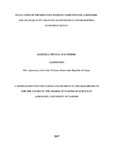Evaluation of promiscuous soybean varieties for agronomic and grain quality traits in maize/soybean inter-cropping systems in Kenya.

View/
Date
2017Author
Habineza, Jean P M
Type
ThesisLanguage
enMetadata
Show full item recordAbstract
Soybeans which nodulate effectively with diverse indigenous rhizobia are considered as promiscuous. As such, determination of their suitability in the intercrop system is important. Three varieties namely ; GAZELLE, SB19 and TGX1990 – 5F were used in this study to identify the most suitable promiscuous variety for intercropping with maize at KALRO Embu and KALRO Mwea, Kenya in the long rains of 2016 and short rains of 2016-2017. In addition, the varieties were used to determine the effects of intercropping maize-soybean on soil fertility and grain quality traits. The experimental design was laid out in randomised complete block design replicated three times with seven treatments where T1= SB19, T2 = GAZELLE, T3 = TGX1990 – 5F, T4 = SB19 + MAIZE, T5 = GAZELLE + MAIZE, T6 = TGX1990-5F + MAIZE, T7 = MAIZE (Duma 43). The spacing used was 80cm between rows of maize and 25cm within rows. Soybean was planted between 2 rows of maize at a spacing of 15cm within rows. The arrangement of intercropping was 1:1 which means, one row of maize intercepted with one row of soybean. Data collection was done on germination %, plant height (cm), days to 50% flowering, days to 75% maturity, yield biomass per plant, 100 grain weight, grain yield, harvest index and Land Equivalent Ratio for both crops. In addition, number of nodules per plant, shattering score (1-5), number of pods per plant, number of seeds per pod were collected for soybean only. Data were subjected to ANOVA and means separated using LSD0.05. The results showed that growth and production parameters were significantly different (p ≤ 0.05). The sole crops showed the highest plant height (PHt) compared to the intercropping indicating that intercropping reduced soybean plant height in both rainy seasons. Mwea recorded taller plants compared to Embu in both rainy seasons. TGX1990-5F showed taller PHt followed by SB19 while GAZELLE recorded the lowest PHt in both sites in both rainy seasons.
Publisher
University of Nairobi
